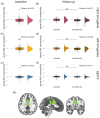Amygdala activity after subchronic escitalopram administration in healthy volunteers: A pharmaco-functional magnetic resonance imaging study
- PMID: 39364684
- PMCID: PMC11531087
- DOI: 10.1177/02698811241286773
Amygdala activity after subchronic escitalopram administration in healthy volunteers: A pharmaco-functional magnetic resonance imaging study
Abstract
Background: Selective serotonin reuptake inhibitors (SSRIs) are used for the treatment of several conditions including anxiety disorders, but the basic neurobiology of serotonin function remains unclear. The amygdala and prefrontal cortex are strongly innervated by serotonergic projections and have been suggested to play an important role in anxiety expression. However, serotonergic function in behaviour and SSRI-mediated neurobiological changes remain incompletely understood.
Aims: To investigate the neural correlates of subchronic antidepressant administration.
Methods: We investigated whether the 2- to 3-week administration of a highly selective SSRI (escitalopram) would alter brain activation on a task robustly shown to recruit the bilateral amygdala and frontal cortices in a large healthy volunteer sample. Participants performed the task during a functional magnetic resonance imaging acquisition before (n = 96) and after subchronic escitalopram (n = 46, days of administration mean (SD) = 15.7 (2.70)) or placebo (n = 40 days of administration mean (SD) = 16.2 (2.90)) self-administration.
Results: Compared to placebo, we found an elevation in right amygdala activation to the task after escitalopram administration without significant changes in mood. This effect was not seen in the left amygdala, the dorsomedial region of interest, the subgenual anterior cingulate cortex or the right fusiform area. There were no significant changes in connectivity between the dorsomedial cortex and amygdala or the subgenual anterior cingulate cortex after escitalopram administration.
Conclusions: To date, this most highly powered study of subchronic SSRI administration indicates that, contrary to effects often seen in patients with anxiety disorders, subchronic SSRI treatment may increase amygdala activation in healthy controls. This finding highlights important gaps in our understanding of the functional role of serotonin.
Keywords: Functional magnetic resonance imaging; antidepressants; anxiety; emotion; escitalopram.
Conflict of interest statement
Declaration of conflicting interestsThe author(s) declared the following potential conflicts of interest with respect to the research, authorship, and/or publication of this article: OJR held an MRC-Proximity to discovery award with Roche (who provide in-kind contributions and have sponsored travel for ACP) regarding work on heart-rate variability and anxiety. He also has completed consultancy work for Peak, IESO digital health, Roche and BlackThorn therapeutics. OJR sat on the committee of the British Association for Psychopharmacology until 2022. ACP sits on the Council for the British Association for Psychopharmacology and has received funding from the Wellcome Trust and Academy of Medical Sciences for unrelated projects. TM is currently employed by the Wellcome Trust. The other authors declare no competing interests.
Figures



Similar articles
-
Escitalopram effects on insula and amygdala BOLD activation during emotional processing.Psychopharmacology (Berl). 2008 Mar;196(4):661-72. doi: 10.1007/s00213-007-1004-8. Epub 2007 Dec 6. Psychopharmacology (Berl). 2008. PMID: 18058090 Free PMC article. Clinical Trial.
-
Area-specific modulation of neural activation comparing escitalopram and citalopram revealed by pharmaco-fMRI: a randomized cross-over study.Neuroimage. 2010 Jan 15;49(2):1161-70. doi: 10.1016/j.neuroimage.2009.10.013. Epub 2009 Oct 13. Neuroimage. 2010. PMID: 19833214 Clinical Trial.
-
Impact of 5-HTTLPR on SSRI serotonin transporter blockade during emotion regulation: A preliminary fMRI study.J Affect Disord. 2016 May 15;196:11-9. doi: 10.1016/j.jad.2016.02.019. Epub 2016 Feb 10. J Affect Disord. 2016. PMID: 26896742 Clinical Trial.
-
Acute Neurofunctional Effects of Escitalopram in Pediatric Anxiety: A Double-Blind, Placebo-Controlled Trial.J Am Acad Child Adolesc Psychiatry. 2021 Oct;60(10):1309-1318. doi: 10.1016/j.jaac.2020.11.023. Epub 2021 Feb 4. J Am Acad Child Adolesc Psychiatry. 2021. PMID: 33548492 Free PMC article. Clinical Trial.
-
[Escitalopram: a selective inhibitor and allosteric modulator of the serotonin transporter].Encephale. 2007 Dec;33(6):965-72. doi: 10.1016/j.encep.2007.11.001. Epub 2007 Dec 11. Encephale. 2007. PMID: 18789789 Review. French.
Cited by
-
The medial prefrontal cortex as a proposed regulatory structure in the relationship between anxiety and perceived social support: a review.BMC Psychol. 2025 Feb 21;13(1):152. doi: 10.1186/s40359-025-02449-x. BMC Psychol. 2025. PMID: 39985115 Free PMC article.
References
-
- Assmann SF, Pocock SJ, Enos LE, et al.. (2000) Subgroup analysis and other (mis)uses of baseline data in clinical trials. Lancet 355: 1064–1069. - PubMed
-
- Baldwin DS, Anderson IM, Nutt DJ, et al.. (2014) Evidence-based pharmacological treatment of anxiety disorders, post-traumatic stress disorder and obsessive-compulsive disorder: A revision of the 2005 guidelines from the British Association for Psychopharmacology. J Psychopharmacol 28: 403–439. - PubMed
-
- Baldwin DS, Asakura S, Koyama T, et al.. (2016) Efficacy of escitalopram in the treatment of social anxiety disorder: A meta-analysis versus placebo. Eur Neuropsychopharmacol 26: 1062–1069. - PubMed
-
- Bandelow B, Reitt M, Röver C, et al.. (2015) Efficacy of treatments for anxiety disorders: A meta-analysis. Int Clin Psychopharmacol 30: 183–192. - PubMed
Publication types
MeSH terms
Substances
Grants and funding
LinkOut - more resources
Full Text Sources
Medical

